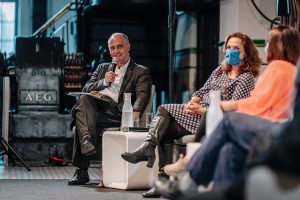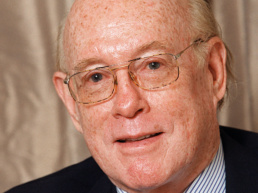What moves a contemporary art collector? What makes you start a collection or choose one piece of art over another? To understand these issues we promoted a conversation between three collectors of contemporary art for a live debate in the Central Tejo of MAAT.
With the moderation of the teacher and researcher, Ana Paula Rebelo Correia, FLAD joined this Saturday the collectors António Cachola, José Correia de Lima, and José Carlos Santana Pinto to talk about their collections of contemporary art and the motivations that lead them to buy art, what influences them to choose some art pieces, but also how they look at the work done in this area, along with the president of FLAD, Rita Faden, and the curator António Pinto Ribeiro.
The opening of the session was of the responsibility of FLAD’s President, Rita Faden, who from the beginning of her term took on the challenge of reviving FLAD’s collection, which has been done with the purchase of new artworks – which was suspended –, the opening of the collection to foreign artists, the restoration of many pieces and its display to the public, which kicked off with the exhibition Feast. Feast. Fury. Femina – Works from FLAD’s Collection., which is on exhibit at the Central Tejo of the MAAT until the end of January.
“From the beginning it was evident to me that it was necessary to resume acquisitions and give life to the collection, not having the concern to fill all the gaps since it stopped [de comprar obras] , but keeping us faithful to the spirit of the collection. But also make her known. We have a responsibility to society for the collection we have.” – Rita Faden, president of FLAD.

From there followed a lively conversation among collectors who, from very different perspectives, agreed that greater effort is needed to give visibility and increase interest in contemporary art. António Cachola, a trained economist who started his collection about three decades ago – and whose collection received the “A” Award for a private collection in Madrid, awarded by the ARCO Foundation – said that from an early age he wanted his collection to be presented in his hometown of Elvas. But also that preparation is necessary for the presentation to the public.
“I felt, early on, that it would be in my city. Elvas is a very beautiful city, with historical, religious heritage, that one day would be recognized nationally. That was the starting point. [The collection] it should be prepared to be presented to the public, because the taste of the public is very diverse.” – António Cachola.

An art collector for 40 years, José Carlos Santana Pinto, began by telling the story of his first collection and what led him to flee from his grandfather and the maid who brought him to school: a collection of bottle caps that he found on the floor of the taverns he passed through on the way to school.
“I had a huge fascination because at that time there were a lot of brands of things and I, at the age of seven or eight, got a huge infection in my hands.” – José Carlos Santana Pinto.
Challenged by the moderator to explain a controversial phrase about his understanding of art (he said that “all art is useless”), José Carlos Santana Pinto explained that for himself, “the beautiful has to be pragmatic too, you need to ask questions.”

José Correia de Lima, a shoe entrepreneur from São João da Madeira, explained that he began collecting art in an emotional way, buying what he liked and admitting that he was not an expert. “I don’t know anything about contemporary art,” he said.
But above all, he says, contemporary art has to be explained, contextualized, so that one can perceive its real value and at the same time generate interest in works and artists, something that, in his view, is not currently done.
“This has to be taught, if it is not taught, it cannot be understood. Show it, bring the public, mediation is a very important thing for people to start learning what contemporary art is. This is lack of work, and yet contemporary art is a restricted thing, an elite thing. Put it in the schools, put it in the town hall, put it on the streets. When I opened my collection, I didn’t even know what I was doing. I bought what I liked and saw, it was a matter of emotion. When someone tried to explain a picture to me, I ran away from it.” – José Correia de Lima.

The curator of the exhibition Feast. Feast. Fury. Femina.– Works from FLAD’s Collection, António Pinto Ribeiro, stressed that from this conversation it was possible to realize that “there is no art collector profile” and also that “there is not only one path of artistic perception.” António Pinto Ribeiro also highlighted the need to value private collections and put them on display to the public, due to the distinct nature of state collections.
“Private collections are a fundamental complement, of people or organizations, to have access to art, be it contemporary, be it ancient art. It doesn’t seem to me that the division between private and public institutions still applies. They’re complementary.” – António Pinto Ribeiro.

Don’t miss the exhibition Feast. Fury. Femina.– Works from FLAD’s Collection in the Central Tejo from the MAAT, until the end of January. For more information, click here.
Related Posts
March 25, 2025
Note of Condolence – Charles Buchanan (1934-2025)
March 24, 2025
Applications Open: FLAD/Saab Visiting Professor at UMass Lowell 2026
Portuguese professors can apply to…
March 17, 2025
FCT and FLAD sign new protocols with the University of California
The objective is to promote academic…


